park assist TOYOTA AURIS 2011 Owners Manual (in English)
[x] Cancel search | Manufacturer: TOYOTA, Model Year: 2011, Model line: AURIS, Model: TOYOTA AURIS 2011Pages: 524, PDF Size: 25.6 MB
Page 3 of 524
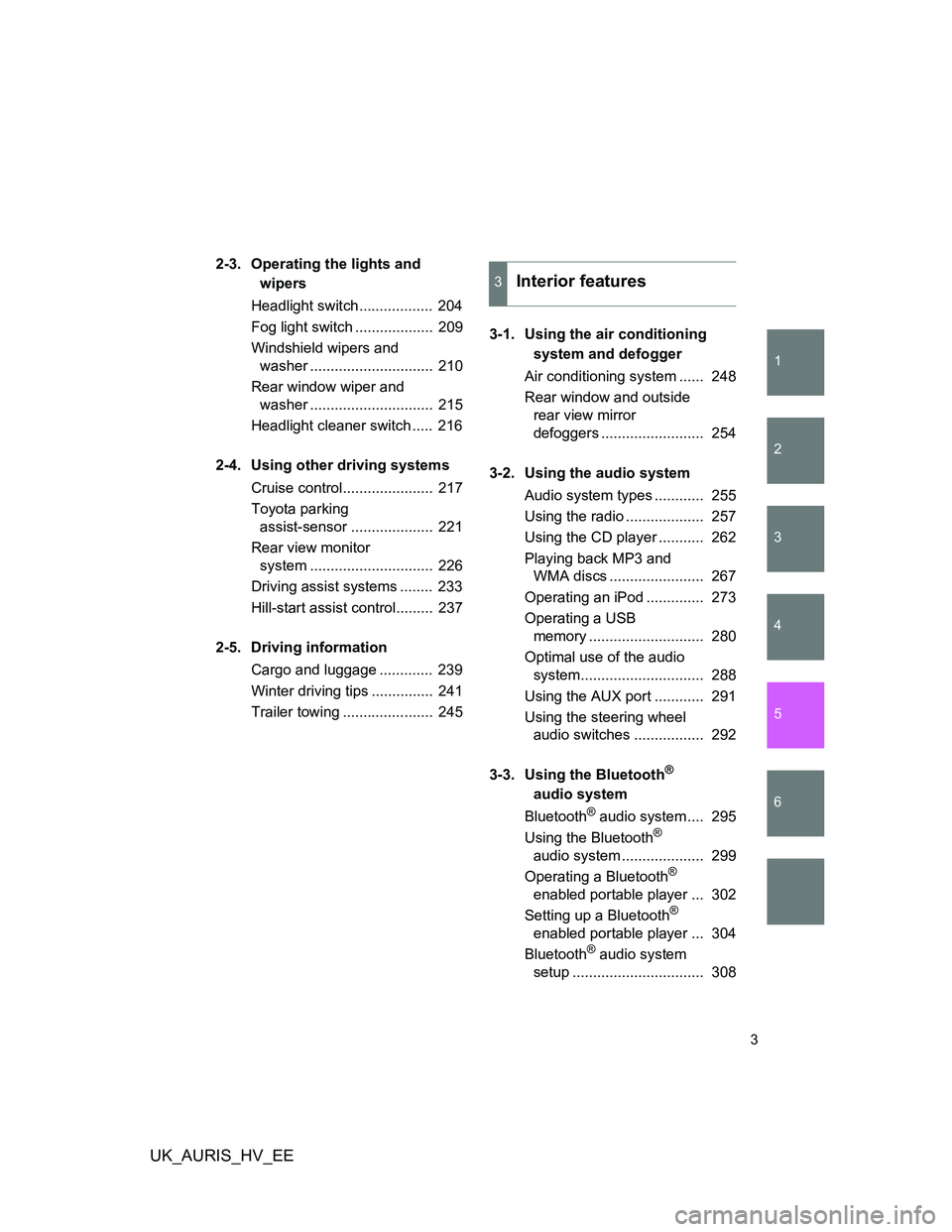
1
2
3
4
5
6
UK_AURIS_HV_EE
3
2-3. Operating the lights and
wipers
Headlight switch.................. 204
Fog light switch ................... 209
Windshield wipers and
washer .............................. 210
Rear window wiper and
washer .............................. 215
Headlight cleaner switch ..... 216
2-4. Using other driving systems
Cruise control...................... 217
Toyota parking
assist-sensor .................... 221
Rear view monitor
system .............................. 226
Driving assist systems ........ 233
Hill-start assist control......... 237
2-5. Driving information
Cargo and luggage ............. 239
Winter driving tips ............... 241
Trailer towing ...................... 2453-1. Using the air conditioning
system and defogger
Air conditioning system ...... 248
Rear window and outside
rear view mirror
defoggers ......................... 254
3-2. Using the audio system
Audio system types ............ 255
Using the radio ................... 257
Using the CD player ........... 262
Playing back MP3 and
WMA discs ....................... 267
Operating an iPod .............. 273
Operating a USB
memory ............................ 280
Optimal use of the audio
system.............................. 288
Using the AUX port ............ 291
Using the steering wheel
audio switches ................. 292
3-3. Using the Bluetooth
®
audio system
Bluetooth
® audio system .... 295
Using the Bluetooth®
audio system .................... 299
Operating a Bluetooth
®
enabled portable player ... 302
Setting up a Bluetooth
®
enabled portable player ... 304
Bluetooth
® audio system
setup ................................ 308
3Interior features
Page 11 of 524
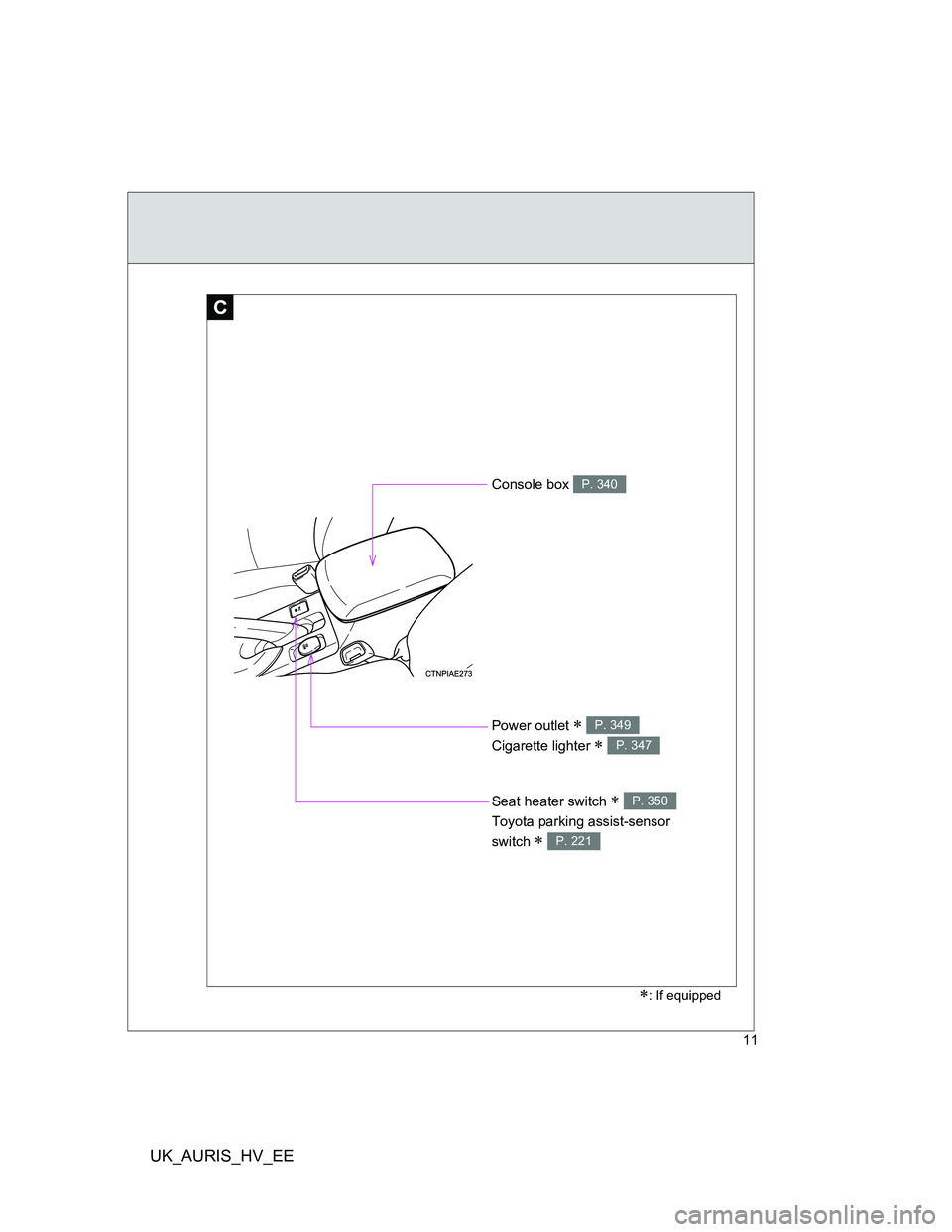
UK_AURIS_HV_EE
11
C
: If equipped
Power outlet
Cigarette lighter
P. 349
P. 347
Console box P. 340
Seat heater switch
Toyota parking assist-sensor
switch
P. 350
P. 221
Page 19 of 524
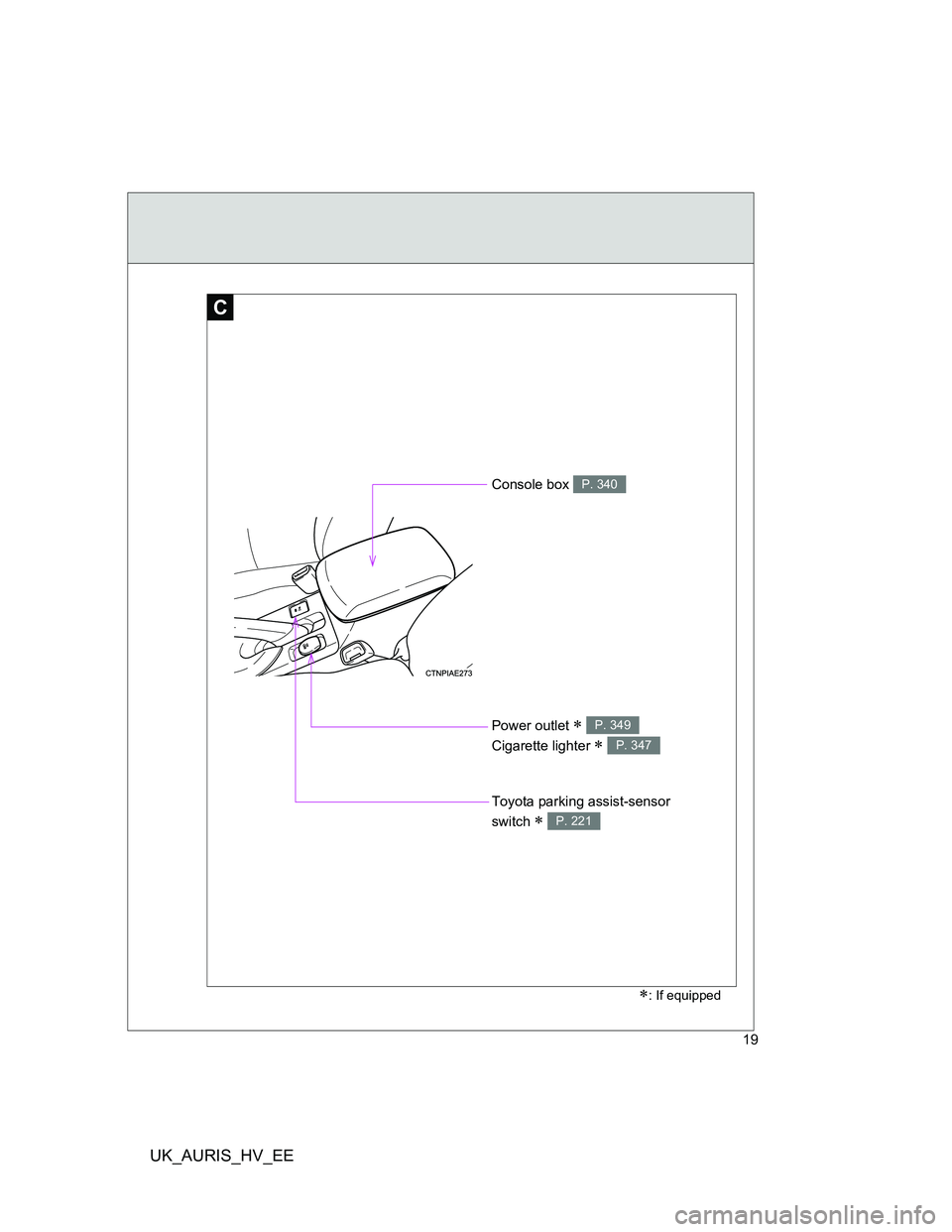
UK_AURIS_HV_EE
19
C
: If equipped
Power outlet
Cigarette lighter
P. 349
P. 347
Console box P. 340
Toyota parking assist-sensor
switch
P. 221
Page 161 of 524
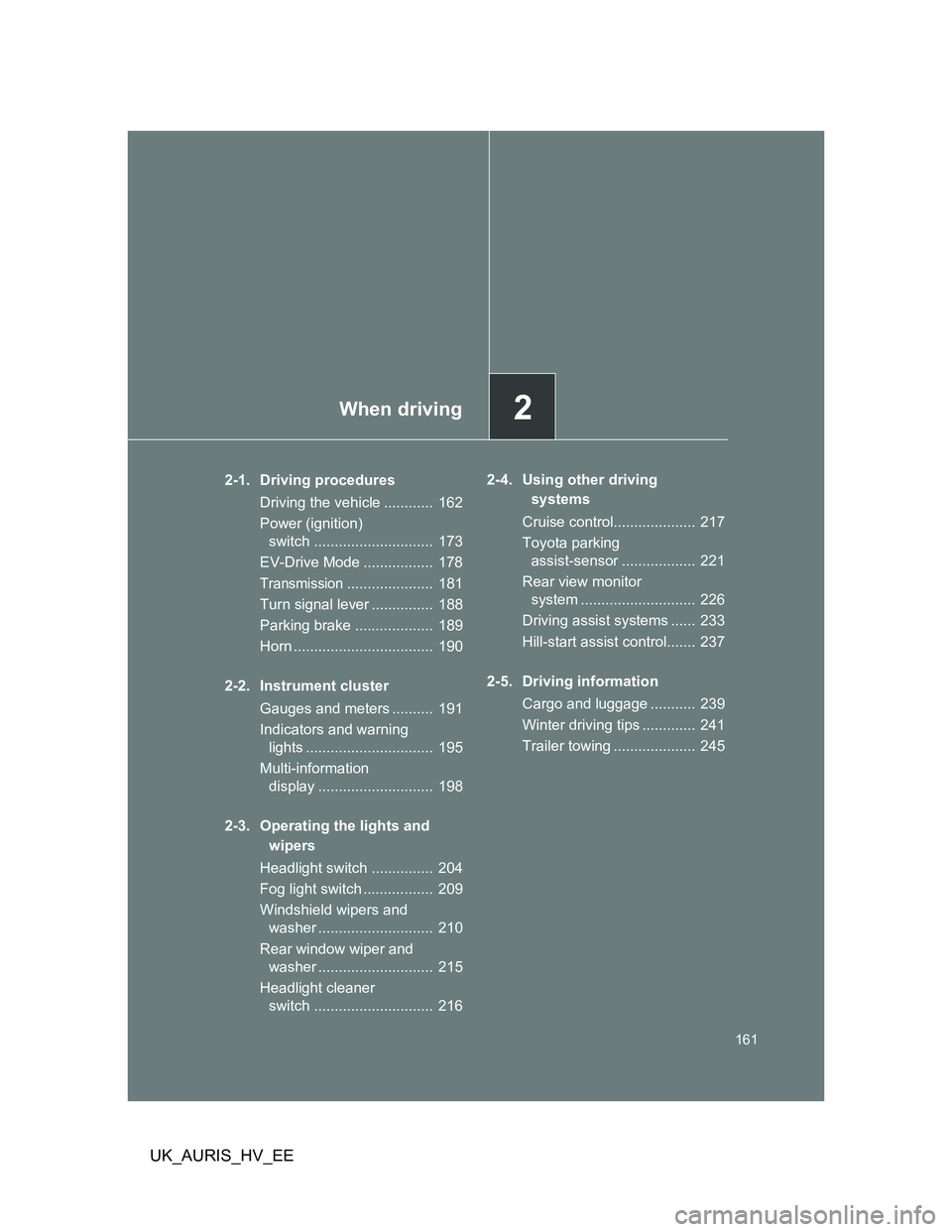
2When driving
161
UK_AURIS_HV_EE
2-1. Driving procedures
Driving the vehicle ............ 162
Power (ignition)
switch ............................. 173
EV-Drive Mode ................. 178
Transmission..................... 181
Turn signal lever ............... 188
Parking brake ................... 189
Horn .................................. 190
2-2. Instrument cluster
Gauges and meters .......... 191
Indicators and warning
lights ............................... 195
Multi-information
display ............................ 198
2-3. Operating the lights and
wipers
Headlight switch ............... 204
Fog light switch ................. 209
Windshield wipers and
washer ............................ 210
Rear window wiper and
washer ............................ 215
Headlight cleaner
switch ............................. 2162-4. Using other driving
systems
Cruise control.................... 217
Toyota parking
assist-sensor .................. 221
Rear view monitor
system ............................ 226
Driving assist systems ...... 233
Hill-start assist control....... 237
2-5. Driving information
Cargo and luggage ........... 239
Winter driving tips ............. 241
Trailer towing .................... 245
Page 167 of 524
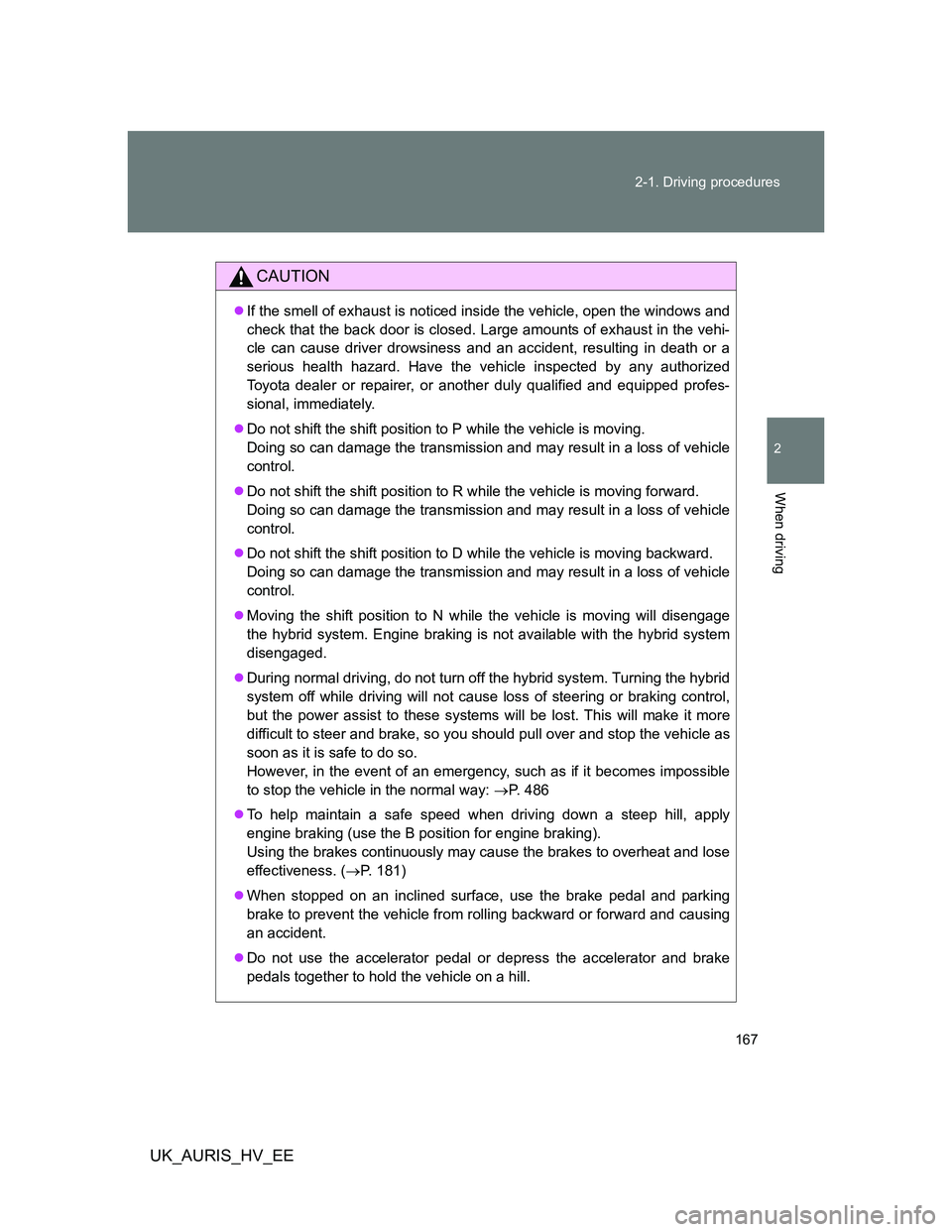
167 2-1. Driving procedures
2
When driving
UK_AURIS_HV_EE
CAUTION
If the smell of exhaust is noticed inside the vehicle, open the windows and
check that the back door is closed. Large amounts of exhaust in the vehi-
cle can cause driver drowsiness and an accident, resulting in death or a
serious health hazard. Have the vehicle inspected by any authorized
Toyota dealer or repairer, or another duly qualified and equipped profes-
sional, immediately.
Do not shift the shift position to P while the vehicle is moving.
Doing so can damage the transmission and may result in a loss of vehicle
control.
Do not shift the shift position to R while the vehicle is moving forward.
Doing so can damage the transmission and may result in a loss of vehicle
control.
Do not shift the shift position to D while the vehicle is moving backward.
Doing so can damage the transmission and may result in a loss of vehicle
control.
Moving the shift position to N while the vehicle is moving will disengage
the hybrid system. Engine braking is not available with the hybrid system
disengaged.
During normal driving, do not turn off the hybrid system. Turning the hybrid
system off while driving will not cause loss of steering or braking control,
but the power assist to these systems will be lost. This will make it more
difficult to steer and brake, so you should pull over and stop the vehicle as
soon as it is safe to do so.
However, in the event of an emergency, such as if it becomes impossible
to stop the vehicle in the normal way: P. 486
To help maintain a safe speed when driving down a steep hill, apply
engine braking (use the B position for engine braking).
Using the brakes continuously may cause the brakes to overheat and lose
effectiveness. (P. 181)
When stopped on an inclined surface, use the brake pedal and parking
brake to prevent the vehicle from rolling backward or forward and causing
an accident.
Do not use the accelerator pedal or depress the accelerator and brake
pedals together to hold the vehicle on a hill.
Page 170 of 524
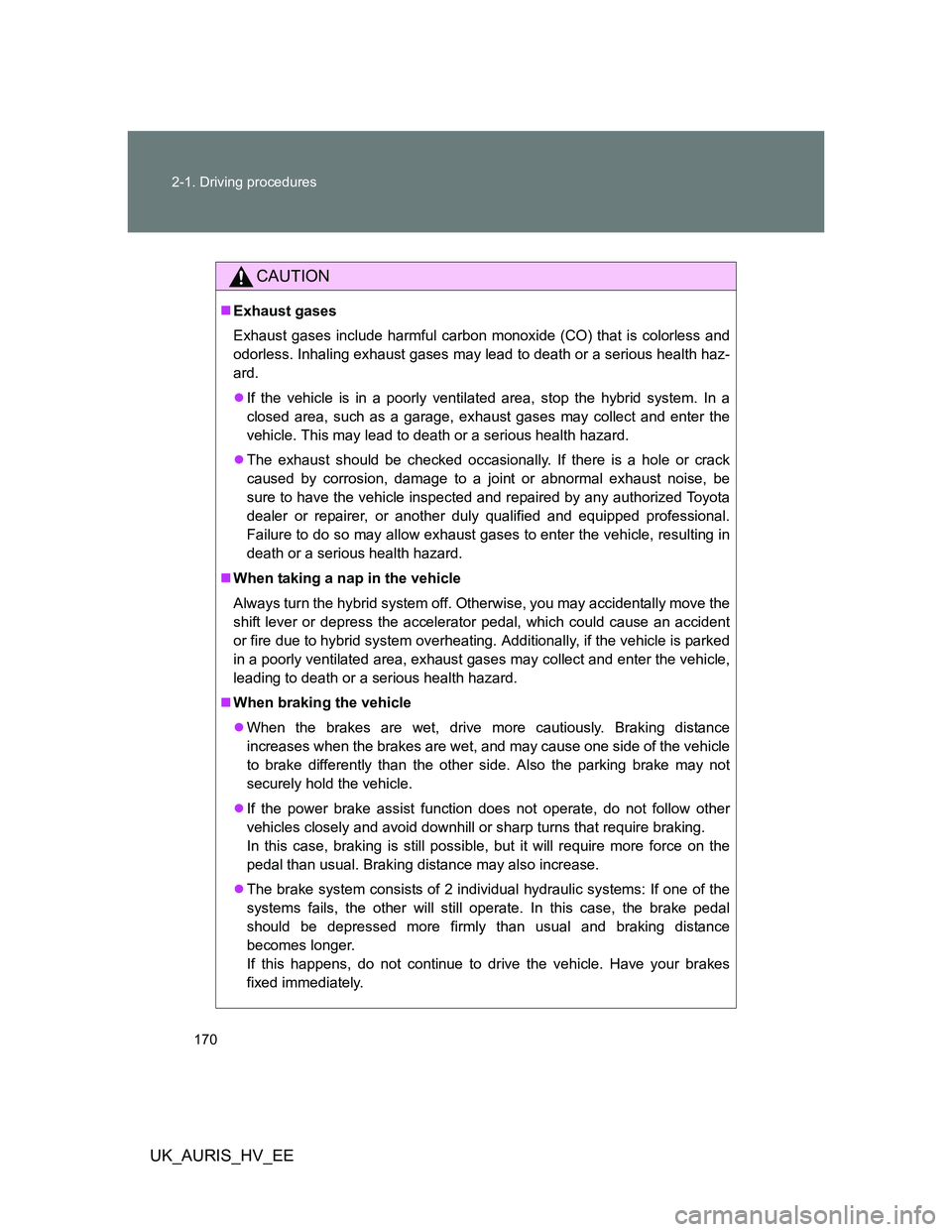
170 2-1. Driving procedures
UK_AURIS_HV_EE
CAUTION
Exhaust gases
Exhaust gases include harmful carbon monoxide (CO) that is colorless and
odorless. Inhaling exhaust gases may lead to death or a serious health haz-
ard.
If the vehicle is in a poorly ventilated area, stop the hybrid system. In a
closed area, such as a garage, exhaust gases may collect and enter the
vehicle. This may lead to death or a serious health hazard.
The exhaust should be checked occasionally. If there is a hole or crack
caused by corrosion, damage to a joint or abnormal exhaust noise, be
sure to have the vehicle inspected and repaired by any authorized Toyota
dealer or repairer, or another duly qualified and equipped professional.
Failure to do so may allow exhaust gases to enter the vehicle, resulting in
death or a serious health hazard.
When taking a nap in the vehicle
Always turn the hybrid system off. Otherwise, you may accidentally move the
shift lever or depress the accelerator pedal, which could cause an accident
or fire due to hybrid system overheating. Additionally, if the vehicle is parked
in a poorly ventilated area, exhaust gases may collect and enter the vehicle,
leading to death or a serious health hazard.
When braking the vehicle
When the brakes are wet, drive more cautiously. Braking distance
increases when the brakes are wet, and may cause one side of the vehicle
to brake differently than the other side. Also the parking brake may not
securely hold the vehicle.
If the power brake assist function does not operate, do not follow other
vehicles closely and avoid downhill or sharp turns that require braking.
In this case, braking is still possible, but it will require more force on the
pedal than usual. Braking distance may also increase.
The brake system consists of 2 individual hydraulic systems: If one of the
systems fails, the other will still operate. In this case, the brake pedal
should be depressed more firmly than usual and braking distance
becomes longer.
If this happens, do not continue to drive the vehicle. Have your brakes
fixed immediately.
Page 221 of 524
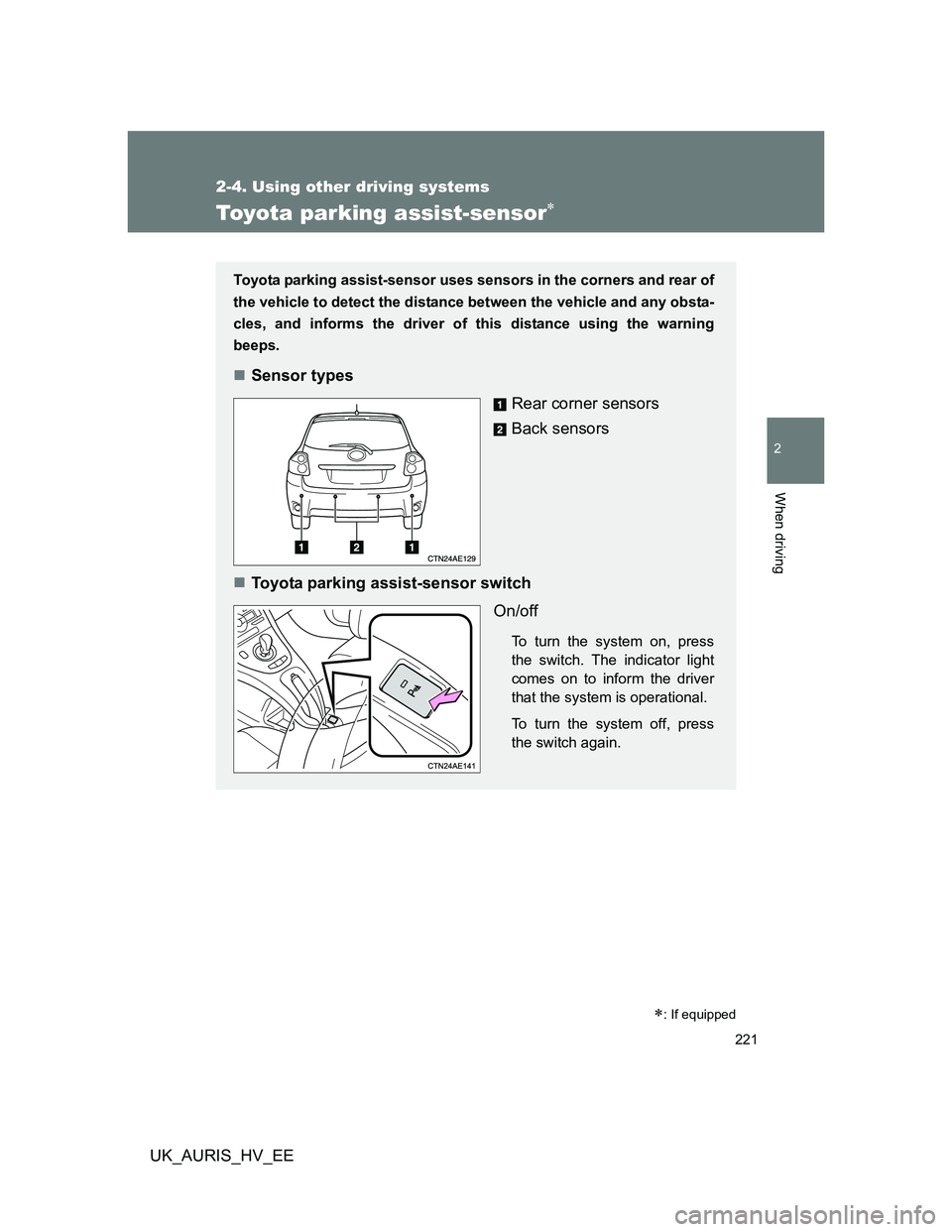
221
2-4. Using other driving systems
2
When driving
UK_AURIS_HV_EE
Toyota parking assist-sensor
: If equipped
Toyota parking assist-sensor uses sensors in the corners and rear of
the vehicle to detect the distance between the vehicle and any obsta-
cles, and informs the driver of this distance using the warning
beeps.
Sensor types
Rear corner sensors
Back sensors
Toyota parking assist-sensor switch
On/off
To turn the system on, press
the switch. The indicator light
comes on to inform the driver
that the system is operational.
To turn the system off, press
the switch again.
Page 223 of 524
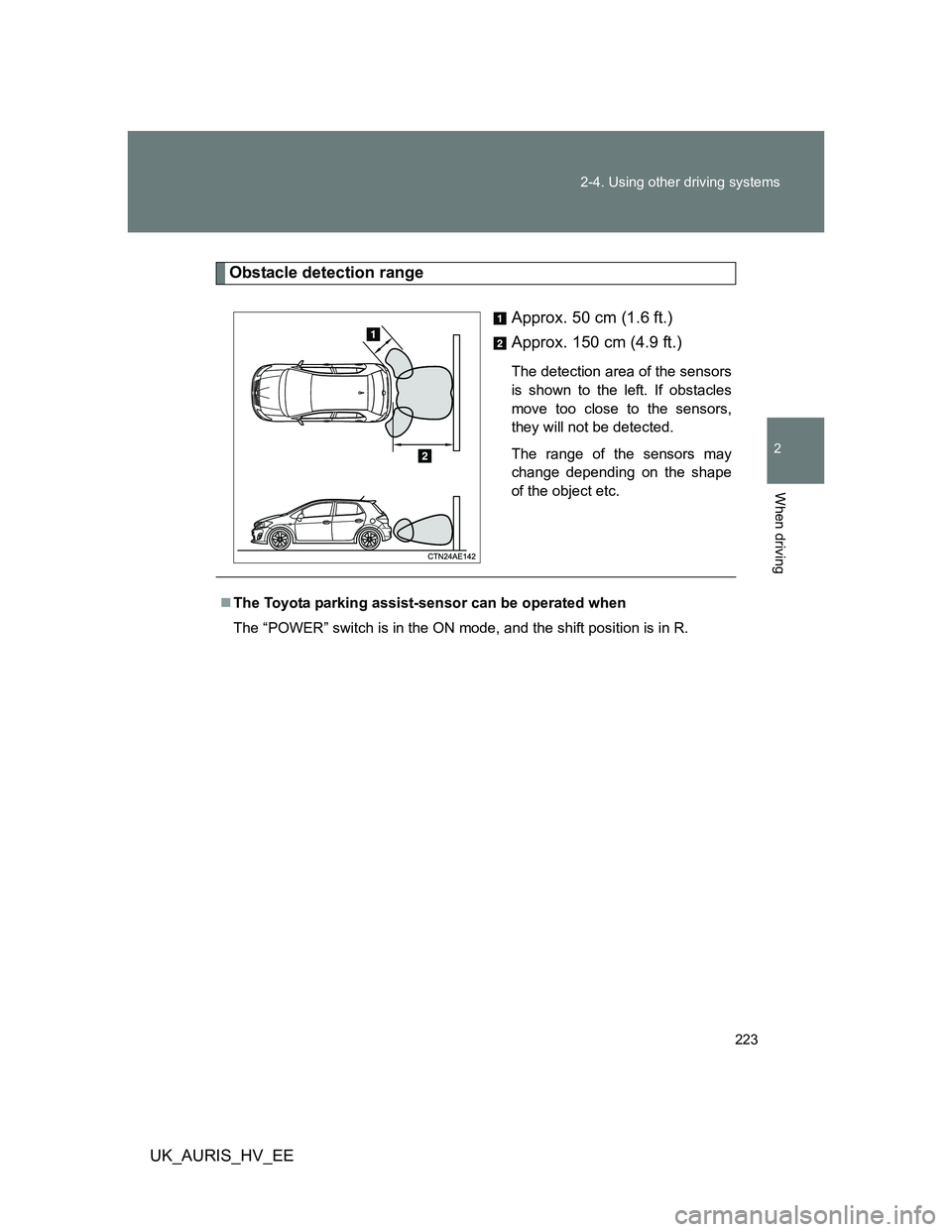
223 2-4. Using other driving systems
2
When driving
UK_AURIS_HV_EE
Obstacle detection range
Approx. 50 cm (1.6 ft.)
Approx. 150 cm (4.9 ft.)
The detection area of the sensors
is shown to the left. If obstacles
move too close to the sensors,
they will not be detected.
The range of the sensors may
change depending on the shape
of the object etc.
The Toyota parking assist-sensor can be operated when
The “POWER” switch is in the ON mode, and the shift position is in R.
Page 224 of 524

224 2-4. Using other driving systems
UK_AURIS_HV_EE
Sensor detection information
Certain vehicle conditions and the surrounding environment may affect
the ability of the sensor to correctly detect obstacles. Particular instances
where this may occur are listed below.
• There is dirt, snow or ice on the sensor. (Wiping the sensor will resolve
this problem.)
• The sensor is frozen. (Thawing the sensor will resolve this problem.)
• The sensor is covered in any way.
• In harsh sunlight or intense cold weather.
• When driving bumpy, sloped or gravel roads, or over grass.
• If there is something producing ultrasonic waves nearby, such as
another vehicle’s horn, motorcycle engine noise, air braking sound
from heavy-duty vehicles, or another vehicle using the park assist sys-
tem.
• In heavy rain, or if water is splashed on the sensors.
• The vehicle is leaning considerably to one side.
• If a commercial fender pole or radio antenna is installed.
• If moving towards a high curb or a curb corner.
• If towing eyelet is installed on your vehicle.
• The bumper or sensor receives a strong impact.
• A non-genuine Toyota suspension (lowered suspension etc.) is
installed.
In addition to the examples above, there are instances in which, because of
their shapes, signs and other objects may be judged by the sensors to be
closer than they are.
The shape of the obstacle may prevent the sensor from detecting it. Pay
particular attention to the following obstacles.
• Thin objects such as wire, fencing or rope.
• Objects that absorb sound waves, such as cotton or snow.
• Objects with sharp corners.
• Low objects.
• Objects where the upper section projects out over the lower section.
Page 225 of 524
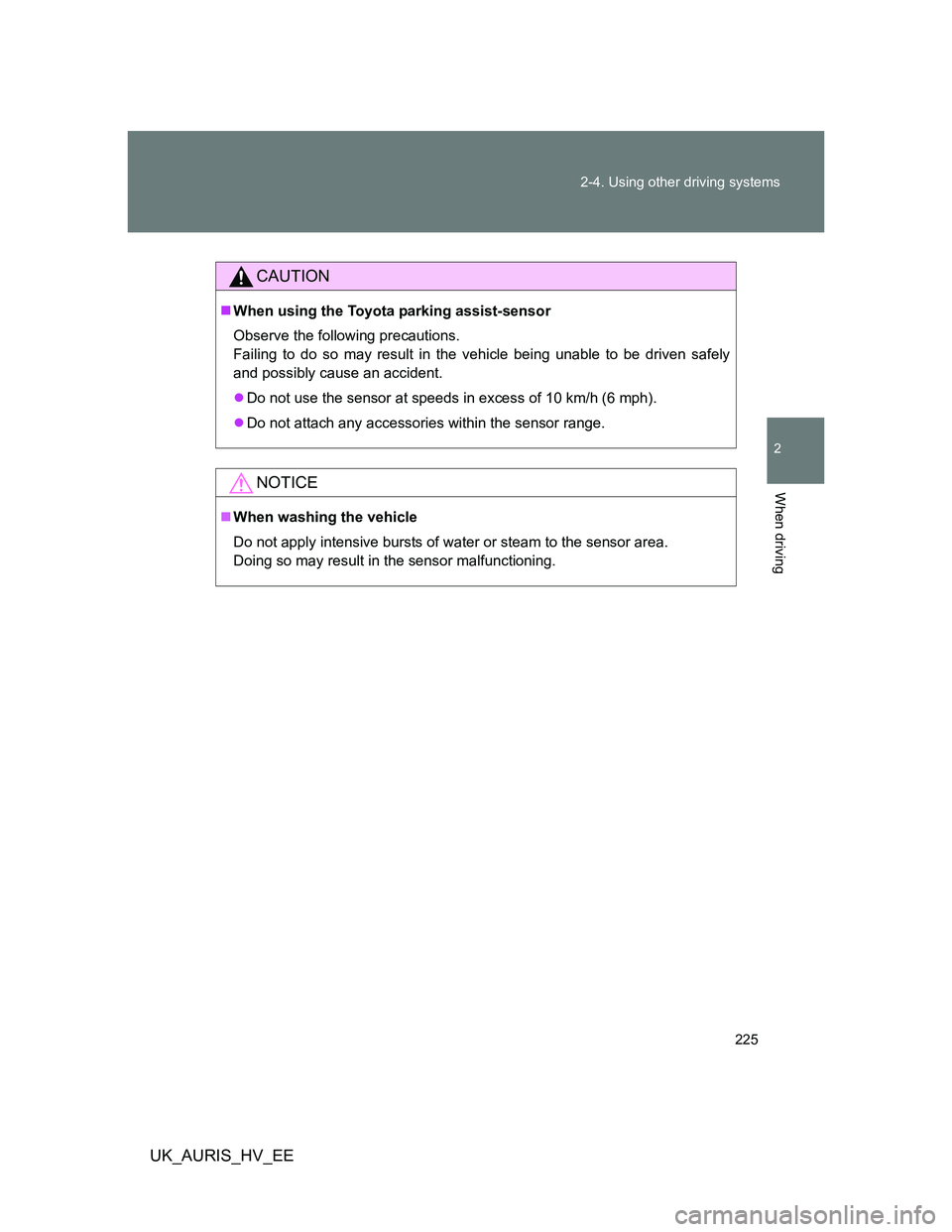
225 2-4. Using other driving systems
2
When driving
UK_AURIS_HV_EE
CAUTION
When using the Toyota parking assist-sensor
Observe the following precautions.
Failing to do so may result in the vehicle being unable to be driven safely
and possibly cause an accident.
Do not use the sensor at speeds in excess of 10 km/h (6 mph).
Do not attach any accessories within the sensor range.
NOTICE
When washing the vehicle
Do not apply intensive bursts of water or steam to the sensor area.
Doing so may result in the sensor malfunctioning.